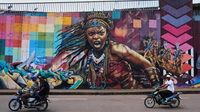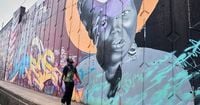In the bustling heart of Conakry, Guinea’s capital, a new kind of art is transforming both city walls and public perceptions. On October 19, 2025, under the glare of the midday sun, Omar Diaw—known by his artist name “Chimere” (French for chimera)—strode up to a blank wall off the city’s main thoroughfare and began to spray-paint. As his fellow artists unloaded dozens of paint cans onto the roadside, neither police nor passersby seemed concerned. In fact, many barely batted an eye, a clear sign of changing attitudes in a city where graffiti was once seen as outright vandalism.
“They know who I am,” Diaw said with quiet confidence, according to the Associated Press. It’s not entirely clear who he meant, but in a place where street art was almost nonexistent just a few years ago, his reputation now precedes him. Diaw’s journey from outsider to celebrated muralist reflects a broader shift across West Africa, where graffiti is not only gaining acceptance but is reshaping urban landscapes and sparking important conversations.
Diaw, originally from Senegal, has witnessed the evolution of graffiti firsthand. In his native country, modern urban street art has flourished for years, but when he moved to Guinea in 2018, he found a blank canvas in more ways than one. “It was thought that graffiti was vandalism,” he recalled. Determined to change this perception, Diaw adopted a gentle approach, using his art to support public awareness campaigns. One of his first projects in Conakry aimed to promote COVID-19 preventive measures. “We had to seduce the population,” he explained, highlighting the need to earn trust before introducing something so new to the city’s culture.
Conakry, a port city grappling with rapid urbanization, has since seen its concrete-heavy landscape transformed by Diaw’s larger-than-life murals. His works feature famous Guinean musicians, African independence leaders, and even political figures such as Gen. Mamadi Doumbouya, who took power in a 2021 coup. These vibrant images now tower over overloaded trucks and bustling crowds, while laundry sometimes dries above the portrait of famed resistance fighter Samory Toure. The signature tag of Diaw’s graffiti collective, Guinea Ghetto Graff, is now a familiar sight on walls all over the city.
But how did graffiti, once regarded as an American import and a symbol of rebellion, come to be embraced in West Africa? The story stretches back to the late 1980s, when Amadou Lamine Ngom—known as “Docta”—became the region’s first graffiti artist. Starting in Dakar, Senegal, in 1988, Ngom and a group of fellow artists were commissioned the following year to paint murals for an awareness campaign aimed at cleaning up the city’s streets. At the time, Ngom mostly worked at night, wary of public and official scrutiny.
That would soon change. “I decided to do it in broad daylight,” Ngom said, as reported by the Associated Press. “So as not to copy what’s happening in the United States, Europe or elsewhere. To create graffiti that resembles the African reality, taking into account our reality, our values.” Ngom’s shift to daylight painting was a turning point, signaling that graffiti could be both public and positive. As his art began to reflect the lives and experiences of local communities, respect for the murals grew—and so did public support. “With the public’s backing, the authorities didn’t have a choice,” Ngom said, underscoring how grassroots acceptance can override official skepticism.
Ngom later mentored the teenage Diaw, passing on both artistic techniques and a philosophy rooted in community engagement. Today, graffiti in Senegal has grown more assertive, often serving as a medium for political messaging, especially around anti-government protests. In Guinea, Diaw’s murals have tackled issues from migration to public health, always with an eye toward local relevance and impact.
Official attitudes have shifted as well. In Conakry, Diaw said the city’s governor has given him carte blanche to paint wherever he wants. This level of support is rare for street artists anywhere in the world, let alone in a city where graffiti was once taboo. As Diaw’s latest mural—featuring Gen. Doumbouya—took shape beside the thoroughfare, passersby stopped to admire the work. Ousmane Sylla, a 22-year-old driver, was already familiar with Diaw’s gigantic paintings near the airport. “It reminds us of old Guinean musicians. It reminds us of history,” Sylla told the Associated Press. “Graffiti is good for Africa, it’s good for this country, it’s good for everyone. I like it, and it changed the face of our city.”
Yet, as graffiti finds its place in the public sphere, questions of inclusivity remain. The art form is still largely male-dominated in Guinea, a reality that some artists are eager to change. “I would really like to see more women become a part of this, because they say that (graffiti) is for men,” said Mama Aissata Camara, one of the few women active in Guinea’s graffiti scene. Her call for greater diversity reflects a broader movement to ensure that the city’s walls represent all voices, not just those of a select few.
Diaw’s collective, Guinea Ghetto Graff, continues to push boundaries, both artistically and socially. Their murals are more than just decoration; they’re a living record of the city’s evolving identity. From honoring resistance fighters and musicians to addressing contemporary issues, these works invite residents to see their own stories reflected in public spaces. And as more artists—perhaps including more women—join the movement, the city’s walls are likely to become even richer canvases for shared expression.
It’s a remarkable turnaround for a city where, not even a decade ago, graffiti was dismissed as vandalism. Thanks to artists like Diaw and the trailblazers before him, Conakry is now at the forefront of a West African graffiti renaissance. The art form is spreading, public attitudes are shifting, and the city’s concrete jungle is blooming with color and meaning. The next chapter, it seems, will be written not just in paint, but in the hearts and minds of those who stop to look—and perhaps, one day, pick up a can themselves.

